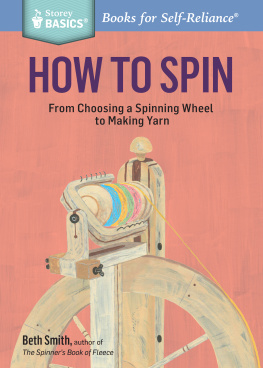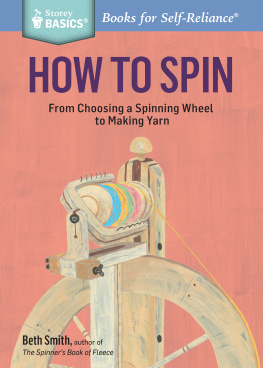
Cover and interior design, Laura Shaw Design Inc.
Text 2008 by Maggie Casey. Photography and illustrations Interweave Press LLC, 2008
All rights reserved.

Interweave Press LLC, 201 East Fourth Street, Loveland, CO 80537-5655 USA
Library of Congress Cataloging-in-Publication Data
Casey, Maggie, 1943
Start spinning : everything you need to know to make great yarn / Maggie Casey, author.
p. cm.
Includes bibliographical references and index.
ISBN 978-1-59668-065-4 (pbk.)
ISBN 978-1-62033-022-7 (PDF)
ISBN 978-1-62033-200-9 (ePub)
1. Hand spinning. 2. Spun yarns. I. Title.
TT847.C35 2008
746.1'2--dc222007036774
Table of Contents
Why should the ancient craft of spinning be so appealing today? We dont need to spin to clothe ourselves when a quick trip to the nearest shopping center offers a world of choices. We no longer travel on ships with handspun sails controlled by handspun rope. Why, then, are we so drawn to spinning?
Spinning is the thread that connects us to our past. In many creation stories, spinning plays a crucial role: Spider Woman brought spinning to the Navajo. Myths and legends and fairy tales are full of spinning references. In Greek mythology, Arachne challenged the goddess Athena to a spinning contest, lost, and was turned into a spider. Then there are the three Fates, who spin the thread of life, measure it out, and decide when to cut it off. As children, we fell asleep hearing about Sleeping Beauty, who pricked her finger on a spinning wheel, and Rumpelstilskin, who spun straw into gold.
Today we dont need to spin our own yarn, but the wonderful thing is that we can. And when we do, a new world opens to us. We can choose the fiber. Do you want wool, silk, or mohair? What kind of woolMerino soft or Lincoln strong? What about linen or cotton or the new fibers like Soysilk or bamboo? We can spin a yarn that is fat or thin, soft or firm. We can spin a single strand or many plies. We can dye the fiber before it is spun or dye the finished yarn. We can spin the yarn of our dreams!
Spinning is the simple process of pulling out fibers and adding twist. That is all it is: a very simple process with a world of variation.
All it takes is fluff, a spindle or wheel, and patience.
The world is full of exciting, exotic fibers from lustrous, smooth silk to soft, buttery cashmere. Plants give us sturdy linen and fine cotton, and dont forget soy, bamboo, and corn fibers. All of these fibers make beautiful, useful yarns, but wool is the easiest fiber to spin and the best one to learn with.

Crimpy locks of wool
WHY WOOL?
Even spinners who can make yarn with ease from slippery silk or short-fibered cotton often prefer to spin wool because of its unique properties. When wool is spun into yarn, air spaces become trapped by the twist. These air spaces act like a double-paned window and make wool a good insulator. Wool is absorbent; it can absorb thirty percent of its weight in water before it feels wet, which is why wool mittens keep your hands warm and dry even after a snowball fight. Like other protein fibers, wool is fire-resistant. Wool will burn if a flame is held to it but will self-extinguish once the flame is removed.
You can make a wool yarn as soft as a feather or as strong as a ropeit just depends on the breed of sheep you choose. There are many different breeds of sheep and great variety in their wool, but all wools share some common traits.
If you look at a lock or staple of wool (a small bundle or clump of wool fibers within a fleece), the first thing you notice is the crimp (the waviness of the wool fiber). Crimp varies with the breed of sheep. Fine wools such as Merino have a fine fiber with lots of crimp, as many as 30 crimps per inch (2.5 cm). Coarser wools like Wensleydale have thicker fibers and much less crimp. Crimp gives wool its elasticity; you can stretch wool out and when you let it go, it pops back into shape. It is the reason a wool skirt or suit looks crisp and holds its shape. This stretchiness allows wool to resist abrasion and remain strong. Wool yarns elasticity is also what makes it the first choice for beginning knitters; the bounce balances out uneven tension in the stitches. You will also notice the length of the group of fibers, commonly called the staple length. Staple length describes a fibers average length. The staple length of cotton is very shortabout 1 inch (2.5 cm)while a long wool might have a staple length of 68 inches (1520.5 cm). The term originally applied to a lock of wool, but now it is also used to describe other fibers. Knowing the staple length of a fiber makes it easier to draft and spin. To find staple length, measure the length of a few fibers that you pull out and examine. When you draft a long fiber, your hands will need to be farther apart than when drafting a short fiber. Medium-length fibers (35 inches or 7.512.5 cm) are generally easiest to spin, especially in the beginning.
If you looked at a wool fiber under a microscope, you would see small overlapping scales like the bracts on a pinecone. These scales, known as the cuticle, grab on to one another in the spinning process and make a strong yarn. They are also the reason why wool felts.
Wool is widely available and renewablethere are wool festivals all over the world; the ads in Spin-Off magazine offer lots of choices; your local yarn shop may carry spinning fiber; and there is always the Internet.
START FROM THE SHEEP
Spinning fleece you have prepared is the best, like eating your own homegrown, fresh-picked strawberries. A yarn spun from a hand-prepared fleece has more character than yarn spun from commercially prepared fiber. It is the difference between those homegrown strawberries and the frozen ones from the grocery store: both are delicious, but homegrown berries rule!
Dont worry; just because you prepare the fleece doesnt mean you have to raise the sheep. You can find fleece at wool festivals and many county fairs, check out the ads in Spin-Off, or ask at your local yarn shop. If your shop doesnt sell fleece, they may know of someone in the area who raises sheep for handspinners. If you have a weavers guild in your area, they too may know of someone who has a spinners flock. For detailed directions on the delightful process of preparing your own fiber, .

Overlapping scales on wool fiber
Learning to spin on fleece you have prepared is the best, like eating your own homegrown, fresh-picked strawberries.

Next page









